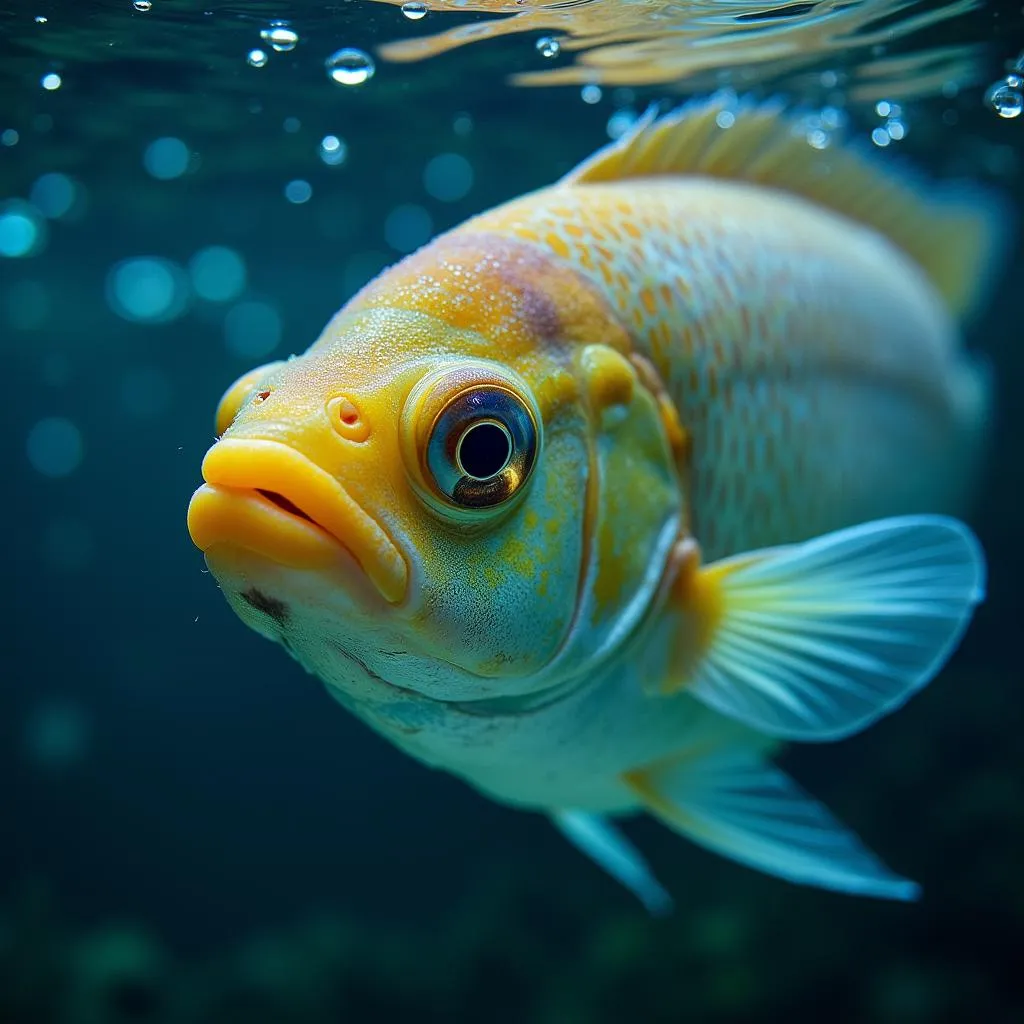Fishing line seems like such a simple thing. It’s just a string, right? But there is a surprising amount of variation in fishing line, and one of the things anglers often wonder about is color. Does line color really matter for fishing? You might be surprised to learn that it often does, and choosing the right line for the conditions can make a big difference in your catch rate.
How Fish See: Debunking the Myths
There are a lot of misconceptions about how fish see, and this leads to confusion about line color. Some anglers think fish see in black and white, or that they can’t see color well at all. This is simply not true. While the specifics of fish vision vary depending on the species and the water conditions, in general, fish see color quite well, often even better than humans.
 Fish Eye Underwater View
Fish Eye Underwater View
Another myth is that fish are always looking up, so they only see the silhouette of the line against the sky. While it’s true that fish often look up to feed, they are also aware of what’s happening around them. They can see your line, especially in clear water or when they are at close range.
Why Line Color Matters
If fish can see color, then it stands to reason that they can see your fishing line. But does the color actually make a difference in whether or not they bite? Here’s why it does:
- Visibility: The most obvious reason line color matters is visibility. A brightly colored line will be much easier for fish to see in clear water than a line that blends in with the surroundings.
- Water Clarity: The color of the water itself plays a huge role in line visibility. In clear water, a less visible line is almost always a better choice. In murky water, line color matters less because the fish won’t be able to see it as well anyway.
- Light Conditions: The amount of light penetrating the water also affects line visibility. Low light conditions, such as at dawn and dusk or on cloudy days, can make even bright lines harder for fish to see.
- Depth: As you go deeper, colors start to fade out. This is why many anglers prefer to use lighter colored lines in deeper water, as they become less visible the further down they go.
 Different Colored Fishing Lines Submerged in Water
Different Colored Fishing Lines Submerged in Water
Choosing the Right Line Color for the Conditions
So, with all that said, how do you choose the right line color for your next fishing trip? Here’s a general guide:
Clear Water:
- Clear or low-visibility lines: These lines are nearly invisible in the water, making them ideal for spooky fish in clear conditions. Fluorocarbon lines are especially known for their low visibility.
- Blue or green lines: These colors can also be effective in clear water, as they mimic the natural hues of the water column.
Murky Water:
- Brightly colored lines: In murky water, visibility is less of an issue, so you can get away with using brighter lines. High-visibility lines in colors like yellow, orange, or red can make it easier to see your line and detect bites.
Deep Water:
- Lighter colors: Lighter colors, even if they seem bright on the spool, tend to fade out more quickly as you go deeper. This makes them a good choice for deep-water fishing.
“Many anglers underestimate the importance of line choice. A subtle change in line color can dramatically impact your success, especially in challenging conditions,” says veteran fishing guide Captain Mark Williams.
Does Line Color Matter for Braided Line?
Braided fishing line is known for its strength and sensitivity, but it is also more visible in the water than monofilament or fluorocarbon. While some anglers believe that the color of braided line doesn’t matter as much because of its inherent visibility, others argue that choosing a color that blends in with the environment can still make a difference. Does it matter what color braided fishing line is a common question among anglers.
Ultimately, the best way to determine if line color affects your catch rate is to experiment with different options and see what works best for you in your local waters.
Conclusion
Does line color matter for fishing? The answer, as with many things in fishing, is: it depends. Understanding the factors that influence line visibility and how fish perceive color can help you make informed decisions about your tackle and improve your chances of success on the water. By choosing the right line for the conditions, you can present your bait more effectively and entice even the wariest of fish.
FAQs
1. What is the most versatile fishing line color?
Green is often considered the most versatile line color as it blends in well with many aquatic environments.
2. Does line color matter for night fishing?
Line color is less critical at night, but some anglers prefer to use a high-visibility line to make it easier to see their line and detect bites.
3. Does using a leader eliminate the need to worry about line color?
While a leader can help, it’s still essential to choose a mainline color that won’t spook fish, especially in clear water.
4. Can changing my line color really make a difference in my catch rate?
Yes, it absolutely can! Subtle changes in your tackle can significantly impact fish behavior, and line color is no exception.
5. What other factors besides color should I consider when choosing fishing line?
Line diameter, pound test, stretch, and abrasion resistance are also important factors to consider based on your target species and fishing style.
Need help choosing the right fishing line for your next trip? Contact us! Our team of experts is available 24/7 to answer your questions and provide personalized recommendations. Call us at 0373298888, email us at [email protected], or visit our store at 86 Cầu Giấy, Hà Nội.

